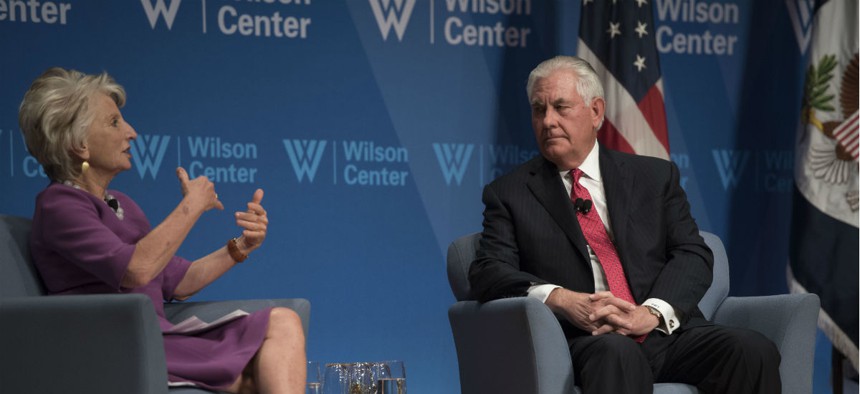
Secretary of State Rex Tillerson participates in a conversation with Wilson Center President and CEO Jane Harman at the Wilson Center in Washington on Nov. 28. Sait Serkan Gurbuz/AP
Tillerson Fills In Some Details of the State Department’s Unfolding ‘Redesign’
“I don’t want to have fire a bunch of people,” said the Secretary of State.
Taking offense at accusations that he is “hollowing out” the State Department, Secretary of State Rex Tillerson on Tuesday praised the career employees he said are running the controversial “redesign” of his agency, fleshing out his team’s plan for new efficiencies and promising to modernize aging information technology.
“I read these articles that there’s this hollowing out. I take offense to that” on behalf of the many acting officials, “because the people that are serving in those roles are doing extraordinary work,” Tillerson said in a speech to a packed room at the Wilson Center in Washington.
Contrary to some complaints in the diplomatic community, “We have the exact same number of Foreign Service officers today—we’re off by 10—that we had at this time in 2016,” he said. “There is a hiring freeze that I’ve kept in place, because as we redesign the organization, we’re probably going to have people that need to be redeployed to other assignments. I don’t want to have a layoff,” Tillerson added. “I don’t want to have to fire a bunch of people. So I said, ‘Let’s manage some of our staffing targets with just normal attrition.’ ”
More than 2,300 applicants have been granted exceptions to the hiring freeze, he continued, estimating that he denied only eight of them. The Senate confirmation process for the pending nominations to fill State’s many upper-tier vacancies, he said, echoing the Trump White House position, “has been excruciatingly slow.”
The State Department’s $55 billion budget—ramped up from the more typical $30 billion in recent years, in Tillerson’s telling—“quite frankly, is not sustainable,” he said. “It is very difficult to execute a $55 billion budget and execute it well.” Future budgets are likely to come down, he added, because of “an expectation that we’re going to have success in some of these conflict areas of getting these conflicts resolved.”
State’s reorganization is something the former CEO of Exxonmobil said he “enjoys,” having been through three in the private sector. But he prefers to call it a “redesign” because after he was sworn in, he was startled to discover that the current organization chart had 82 employees who reported directly to him. The coming changes will affect work processes and are aimed at making it easier for people to do their jobs, he said.
His approach to the redesign, led by five employee teams, began with a “listening exercise” to which 35,000 employees responded, as well as 300 face-to-face interviews with people making suggestions for efficiencies. “We’ve actually selected about 170 of those ideas that we are now perfecting,” he said.
As one example, Tillerson said he was shocked during a visit with employees in the department’s administrative bureau when they recommended he move operations to the cloud. “I looked at them and I said, ‘We’re not in the cloud?’ ”
Overall, the secretary said, the department and its reorganization are “functioning very well from my perspective.” He said his only objective with the organization redesign is to help the career staff.
When he was finished, Jane Harman, president and CEO of the Wilson Center and a former representative to Congress from California, said, “That message will resonate around the world. A lot of people wanted to hear that.”
Tillerson spoke just as the inspector general for the State Department was releasing its annual rundown of the agency’s management challenges, which appeared to be aligned with some of the secretary’s agenda.
Among the half-dozen areas of concern to IG Steve Linick are information security and management, workforce management and “promoting accountability through internal coordination and clear lines of authority.”
The IG “has identified program management weaknesses associated with a lack of coordination and dispersed authority as a serious challenge facing the department,” the report said. “Unclear lines of authority and a lack of coordination have particular consequences for both physical and IT security.”
The rundown singled out State’s Bureau of Near Eastern Affairs (which covers Iraq, Israel and Arab nations), saying it “attracted the fewest number of bidders for its domestic positions of any of the regional bureaus, and approximately 75 percent of its overseas positions were designated as hard-to-fill. This places at risk NEA’s ability to develop the next generation of diplomats with expertise in the region,” it said, warning of a growing workload, stress and “employee burnout.”
The IG said management vulnerabilities “do not exist in isolation; rather, many overlap with and exacerbate one another.” He said the problems need to be addressed systematically rather than in a piecemeal fashion.
NEXT STORY: OPM Can Lead the Transformation of Government







